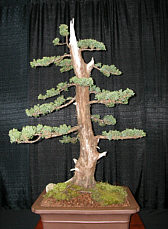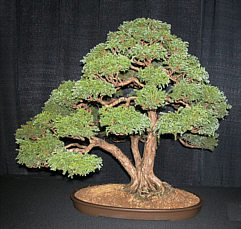


PLANT CARE TIPS
 |
|
|
|
PLANT CARE TIPS |
||
Our Site
Monthly Bonsai Care Instructions
|
Plant Care Tips for JanuaryDuring the bleak winter months, the extreme cold temperatures can take its toll on all of your trees. The main task is to protect them from the very cold weather. Check the soil in the pots to make sure it has not dried out. If so, water the soil so it is just damp. Don't wait until spring to do all of your maintenance! Winter is an excellent time for heavy pruning, new design and carving, needle plucking on pines (2-3 yr old needles). Don't forget to take off old wire and add new wire. This is a good time to plan your repotting schedule for spring. Draw up a list of trees that need repotting and order your soil requirements and any pots you may need. Finally, watch out for mice girdling your trees. Use mothballs or a hungry cat to prevent problems! Plant Care Tips for FebruaryNow is a good time to begin putting together your bonsai compost. A suggested combination would be 1/3 peat, 1/3 garden compost, 1/3 sand or grit, and a slow-release fertilizer (about a handful per 5 gallons). Towards the end of the month, if there are any brief mild spells, it is time to repot and wire those deciduous trees. It is also possible to lift trees from the ground and do some undercutting. Leave evergreens until later. Branch pruning of deciduous and evergreen trees can be done (except Japanese maples and pines). Any major redesign and reshaping of trees can be done now. Pines and evergreens can be grafted now. Plant Care Tips for MarchMarch is the perfect time to repot, and to branch- and root-prune. Trees less than 5 years old should be repotted annually, trees between 5 and 20 years old may be repotted every other year, and trees over 20 should be repotted every 3 years. By the end of March, depending on weather conditions, trees can be gradually brought out of winter shelter. Evergreens may be fertilized now and, in general, you may spray for fungus and insects on a warm day. March is really the last month deciduous trees can be lifted from the ground, as buds have not yet broken. Evergreens can be lifted until the end of April. March and April are also good months to dig trees from the wild, keeping as much fibrous root attached as possible. Keep your trees cool. Don't be in a hurry to encourage early growth, as it can still get cold. March is a great month for repotting, and for digging planted trees and collecting field grown ones. Plant Care Tips for AprilReady, set, GO! April is still a decent month for root-pruning, and for digging trees from yard or field. Begin your feeding, pinching, watering, and pruning schedules in earnest. Of course, be mindful of potential cold snaps, and be ready to protect vulnerable plants. This is the time we've all been waiting for! Plant Care Tips for MayBy May most deciduous trees have come into leaf and new candles on pines have sprouted. Watering should now routinely be done once a day. Cuttings of evergreens may still be taken. Air-layering of deciduous and evergreens can be continued. Pinch back long shoots of deciduous trees as sudden frosts can damage the young leaves. Your feeding, pinching, watering, and pruning schedules should be in full swing by now. May is not too late for repotting or field collecting, but this requires increasingly careful after-care as the season progresses. Trees repotted or collected in May should be protected from strong sun and wind until strong growth is observed, and leafy trees may suffer from transplant shock, so roots should be left intact as much as possible. Careful use of insecticides and fungicides becomes increasingly useful at this time of year. Always read and follow manufacturer's directions, but keep in mind that trees in containers may do better with slightly diluted formulations. Watch wired branches carefully to avoid unsightly spiral scars from bark growing over the wires, deciduous trees in particular can expand very quickly in May and June. Plant Care Tips for JuneIt's getting late to dig or repot hardy trees, though it can still be done if you know what you're doing or have a smart friend. Your feeding, pinching, and pruning schedules should be in full swing by now. Pinch the terminal buds from deciduous trees, leaving only one pair of leaves, and most of your candle-pinching for evergreens will be winding down at this point. Everyone seems to have their own preferences for fertilizers and feeding schedules, so ask around or find a good book. Keep an eye peeled for insect pests and don't overdo it with the chemicals! Always read and follow manufacturers' directions, and be aware that plants in small containers are more easily stressed than plants growing in the ground. If you spray your trees with insecticides or fungicides, it's best to put them into the shade for the rest of the day. Plant Care Tips for July It's generally too late in the season for digging or repotting, though the more experienced can seemingly get away with almost anything. Your feeding, pinching, and pruning schedules should be in full swing by now. Pinch the terminal buds from deciduous trees, leaving only one pair of leaves, and keep plucking the terminal buds off your junipers and cedars as well. Everyone seems to have their own preferences for fertilizers and feeding schedules, so ask around or find a good book. Keep an eye peeled for insect pests and don't overdo it with the chemicals! Always read and follow manufacturers' directions, and be aware that plants in small containers are more easily stressed than plants growing in the ground. If you spray your trees with insecticides or fungicides, it's best to put them into the shade for the rest of the day. Plant Care Tips for AugustSince August can be a very hot and dry month, it is imperative that trees be watered every day, maybe twice daily. Not much else can be done except to feed regularly. From August on, trees will need less nitrogen and more potassium and phosphorus to harden the wood and induce budding. Continue to pot up air layering's that put out roots. Branches start to thicken during August, and wire which begins to bite into the branches should be loosened. August is pretty much about keeping your trees sufficiently watered against the heat, and beginning to harden them up for the coming fall. This is about the time that most people start backing off their feeding, pinching, and pruning schedules. Don't fertilize too aggressively, or else you risk the trees pushing too much new growth that will not harden-off sufficiently before the cold weather comes in. Plant Care Tips for SeptemberIt is about time to begin hardening-off your trees for the cold months ahead, and preparing a safe place to keep them. For the most part you should not attempt collecting, repotting, air-layering or drastic pruning at this time of year. For most of us, the drought has been a stress on our plants, so preparing them for winter is more crucial this year than ever. Feeding: Please note that fertilization must be handled with sensitivity, or else you risk pushing too much new growth that will not harden-off sufficiently before the cold weather sets in. Following the needs of outdoor plantings, it can be said that deciduous trees may benefit from a low-nitrogen (that is, higher in potassium and phosphorous) feeding after the leaves have fallen but prior to November 1; this can promote bud formation and strengthen the trunk and root system for winter. Similarly, evergreens may be fed a low-nitrogen fertilizer, until the end of October. Most reference books refer to a single Autumn feeding. Repotting and Training: Japanese texts recommend autumn repotting for most evergreens, but they also cite early spring for each of these, considering the difference in climate, I'd stick with early spring. Cherry and flowering quince are repotted by the Japanese in October. Many needled evergreens are most successfully wire-trained during the autumn months, but most sources say wait until October or November. Winter protection: Start planning how and where you will store your trees for the winter. In a normal year, and when was the last time we had one of those, most of our outdoor bonsai can stay virtually unprotected beyond Thanksgiving, but this holiday is commonly used as a start date for winter protection. If you have only a few trees, it may be possible to plant them directly into the ground, pot and all, but for larger collections it may prove useful to build some sort of cold-frame or organize some space in an unheated shed or some-such. You will not need these precautions for a few months yet, but it pays to plan ahead! Watering continues to be the most important task during this month. Reduce feeding slightly at this point, and use low-nitrogen or nitrogen-free fertilizer. September is a good month to take hardwood cuttings. This is the last opportunity to pot up air layerings' as they may not be able to root sufficiently to withstand the winter [if you wait longer]. Also remove wires from branches that have set properly and be aware of thickening branches and trunks on wired pines. Plant Care Tips for OctoberTree growth is now drawing to a close, with leaves displaying a final array of color before winter. Watering can definitely be minimized at this time. Heavy branch pruning can be done on pines, and overwinter them in a cool greenhouse. Do not continue to fertilize, begin again in March. It is hardening-off time for your trees, and by now you should have created a safe place to keep them for the cold months ahead. Certain types of trees are repotted or trained at this time of year... see the comments that follow. Most of you realize that the drought has not yet ended, and this continues to put stress on our plants, so preparing them for winter is more crucial this year than ever. Feeding: As reported in last month's newsletter, many authors suggest a single Autumn feeding. Please note that fertilization must be handled with sensitivity, or else you risk pushing too much new growth that will not harden-off sufficiently before the cold weather sets in. Deciduous trees may benefit from a low-nitrogen (that is, higher in potassium and phosphorous) feeding after the leaves have fallen but prior to November 1; this can promote bud formation and strengthen the trunk and root system for winter. Similarly, evergreens may be fed a low-nitrogen fertilizer, until the end of October. Repotting and Training: Japanese texts recommend autumn repotting for most evergreens, but they also cite early spring for each of these, considering the difference in climate, and the drought and all, I'd stick with early spring. Cherry and flowering quince are repotted by the Japanese in October. Many needled evergreens are most successfully wire-trained during the autumn months, but most sources say wait until late October or November. Winter protection: By November you will need to have figured out how and where you will stash your hardy outdoor trees. Thanksgiving is commonly used as a start date for winter protection. If you have only a few trees, it may be possible to plant them directly into the ground, pot and all, and cover the plant with an upturned bushel basket. But for larger collections it may prove useful to build some sort of cold-frame or organize some space in an unheated shed or some-such. Beware of continuing, or surprise, warm weather, if you plan to shed or cold-frame your trees, since these enclosures can remain surprisingly warm, causing trees to pop new buds or refuse to harden off. Plant Care Tips for NovemberDuring November deciduous and evergreen trees can remain out until about the last week of the month. Prepare trees for their winter setting, whether it be a cold frame or whatever type of winter protection you may have. Prior to setting them in their winter quarters, check for insects and spray and remove all dead leaves and branches. Thinking ahead, write down and plan what you need to do for spring and choose which trees you will work on first. Tropicals should already be indoors and you can continue to water, feed, repot and prune them all through the winter. If they are in a heated dry atmosphere, mist frequently. Plant Care Tips for DecemberStart putting Trident and Japanese Maples in the cool greenhouse for winter protection. If you do not have one, a wooden frame covered with plastic sheeting is a good substitute. Continue to spray the trees with an insecticide and fungicide on dry sunny days. By now your deciduous bonsai have shed all but a few of their leaves or needles, and in spite of some unseasonably mild weather, we are looking straight into the gaping maw of the cold season. Your trees need a well-deserved rest, but you needn't go dormant yourselves! It's a great time of year to assess the design of your deciduous trees and wire your evergreen trees, to plan your repotting schedule, mix or purchase bonsai soil, clean up and sharpen your tools, read some good books and periodicals, and travel the countryside looking for suitable material from the field. We've had a warm and exceedingly dry November, so watering is more of a priority than in a more normal fall season. Any non-hardy trees should be inside by now, of course. No more fertilizer for your hardy (outdoor) trees, and you should be able to reduce your watering schedule soon. Remember, leafless trees need less water, but don't allow the soil to dry out completely! This holds true throughout the winter months. Your hardy trees are usually placed into winter protection by early December (if the weather holds up the way it has, you may not need to shelter them for some time yet), so by the Holidays you definitely need to have them stored safely for the season. Remember, winter protection is chiefly concerned with: a) preventing the soil from repeatedly freezing and thawing; b) preventing wind from dehydrating the upper portion of the plant; and c) preventing the soil from drying out completely. You may also have to concern yourself with rodents that sometimes feed on the bark of dormant trees. If you store your trees in a shed or other enclosure, don't do it too early or you may encourage new growth if we get continued warm weather. Wiring may be performed on most conifers during the winter months, but deciduous trees are often too brittle to survive branch-bending, so postpone wiring on leafy trees until spring. |